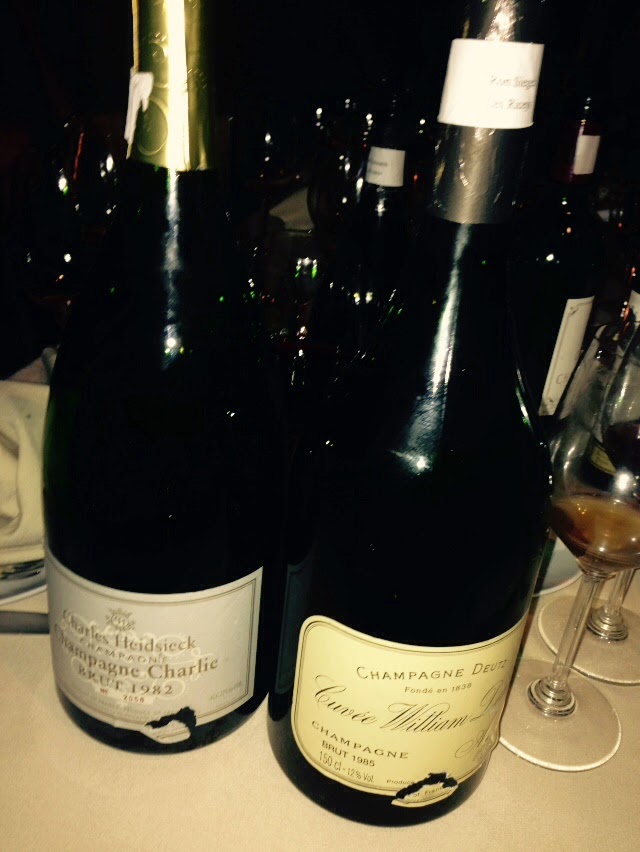 |
| Levi Dalton and Jean-Baptiste Lecaillon |
In response to Levi's opening question, Jean-Baptiste revealed that he had developed an interest in wine at an early age and that had prompted him to study Agronomy -- and then Winemaking -- at Montpellier. He worked in Bordeaux and the US after graduation and then came to Champagne. He currently oversees both the vineyard and winemaking at Louis Roederer.
He sees Champagne as a "climate story" with 50% of the climatic effect being Oceanic and 50% being Continental. Sun, water, and rain all influence grape growing with the chalk soils adding a defining element.
Louis Roederer farms 240 ha of Grand Cru and Premier Cru vineyards, 65 ha of which are farmed biodynamically, the largest commitment to that viticultural approach in all of Champagne. According to Jean-Baptiste, biodynamic farming produces richer, riper fruit.
Massal selection is used for propogation. Jean-Baptiste sees that as key to a necessary diversity in the vineyard.
Roederer Brut Premier
According to Jean-Baptiste, 240 years of history is encapsulated in this wine. The blend is 40% Pinot Noir, 40% Chardonnay, and 20% Pinot Meunier. Seventy percent of the grapes used in this wine is sourced from company-owned vineyards. Petit Meunier grapes are purchased from two sources and helps to round out the blend.
Roederer contends with an inconsistent climate but has to create a consistent wine and they employ horizontal and vertical blending to accomplish this task. For the vertical blending, oak-aged (cask) wines from eight vintages are employed. The strategy is to blend opposites: continental climate wines blended with oceanic climate wines. He is looking for micro-oxygenation, rather than flavors, in his use of oak.
Roederer Brut Natural 2006
Every Louis Roederer generation wants to create a wine that will help to ensure the future of the House. Frédéric (the current Managing Director) is no exception to that rule. He had a vision of a terroir-driven, low-dosage wine and, towards that end, he partnered with Philippe Stark to bring something new to the market. They began with fruit from the 35-ha Cumières vineyard, known for deep, dark clay soils in a south-facing, amphitheater-like setting. According to Jean-Baptiste, clay "sings" in continental years but does not do well in oceanic years. The Cumières terroir provides bigger frruit, acidity, and mineral notes.
The grapes are picked on fruit days (according to the biodynamic calendar). The wines have soft bubbles, creamy taste and a spiciness. The wine has been aged for 10 months in order to build texture. The high acidity drove a decision to go with 4.5 to 5 bars of pressure as high acidity combined with larger bubbles can yield harsh results.
Lemony-lime acidity with spicines on nose cofirmed in a long, spicy finish.
Cristal Brut 1995
This project began in 1995 when they began setting aside some wine for the future. Jean-Baptiste feels that keeping wines on the lees can hide the terroir over time -- not a good outcome if you are trying to produce terroir-driven wines. And, time on lees has to be counter-weighted by time-in-bottle to allow sugar digestion. A wine that spends 5 years on lees should be bottle-aged for an additional 5 years.
Pinot Noir on chalk is the story here as the combination delivers precision and purity. But it is a struggle. The grapes for this wine are secured from vines that are at least 25 years old with an average age of 38 to 40 years (According to Jean-Baptiste, it takes 15 years for the vines to burrow into the bedrock.).
The wines do not undergo malolactic fermentation. Nine grams of sugar are added and this lower dosage results in a more elegant, more refined blend.
Nineteen ninety-five was a classic vintage with half of its influence continental and half oceanic. The wine presented a lemony-lime acidity, with burnt orange and burnt toast notes, and a long, dry, spicy finish.
Cristal Rose 2002
This was a continental year when everything went "swimmingly." Conditions were perfect. The winds came from the north north east in September, resulting in cool nights, bright days, evaporation of water from the grapes, and concentration of grape constituents.
The fruit for this wine was sourced from 50-year-old vines grown in south-facing, biodynamically farmed vineyards in Aÿ. This terroir yields extra-ripe fruit.
The Rose showed ripe fruit (which Jean-Baptiste attributes to the Pinot Noir), orange, orange rind, minerality (attributed to the Chardonnay), bright acidity, and a spicy, long finish. Excellent mousse. The bubbles in this wine were more pronounced than the three previous wines. Fruity and not as biting as the other wines. Hint of tannin resulting from the Pinot Noir used in the blend.
Jean-Baptiste sees the Rose as a 40+-year wine.
©Wine -- Mise en abyme




































